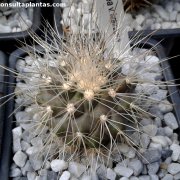Care of the cactus Copiapoa cinerea or Echinocactus cinereus |
|
The genus Copiapoa, family Cactaceae, comprises 25 species of cactus native to northern Chile. Some species are: Copiapoa cinerea, Copiapoa calderana, Copiapoa grandiflora, Copiapoa malletiana, Copiapoa gigantea, Copiapoa humilis, Copiapoa coquimbana, Copiapoa taltalensis, Copiapoa echinoides, Copiapoa krainziana, Copiapoa marginata. This species is native to Chile. Scientific synonyms: Copiapoa columna-alba, Echinocactus cinereus. They are slow-growing cacti with a globular body in their youth (later cylindrical) that reach 1 meter in height. The epidermis is whitish-green in color and they can have 14 to 30 broad, rounded ribs. They have woolly areolas with 5-6 spines when young; in adult specimens they are reduced to a single black spine. The flowers are yellow, appear at the apex and measure up to 3.5 cm (1.37"). They bloom from summer to early fall. When they are young they are used in pots; the adult specimens are used in rockery and in gardens of cacti and succulents. Copiapoa cinerea prefers full sun exposure but can grow in light shade. The winter temperature should not be lower than 4 ºC (39.2 ºF). The soil can be a mixture of 70% siliceous coarse sand and 30% leaf mulch or a commercial cactus substrate with 25% coarse sand. Transplantation is not recommended as its roots are very delicate. Copiapoa columna-alba is very resistant to drought so they are only watered when the substrate is completely dry. In mid-autumn, watering is suspended until spring begins. Fertilize once with mineral cactus fertilizer in spring. Pruning is not necessary. The biggest danger for Echinocactus cinereus is excess moisture that rots tissues. Copiapoa cinerea propagates by seeds but it's a fairly slow process. If it produces suckers they can be separated in spring with great care. |
Images of the cactus Copiapoa cinerea or Echinocactus cinereus |
Find plants
Copiapoa cinerea or Echinocactus cinereus | Care and Growing
© 2025 FavThemes



